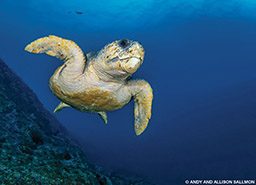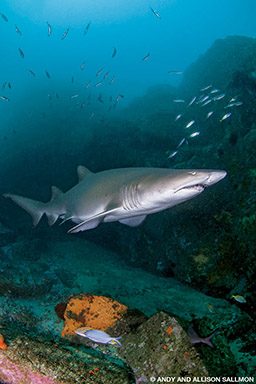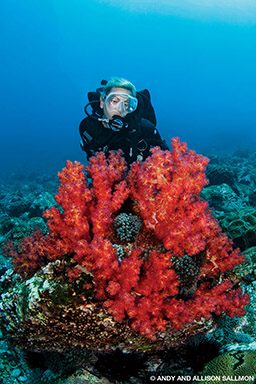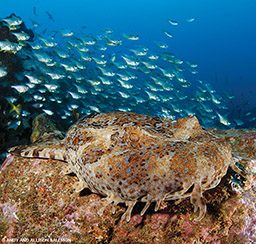Tell divers you’re headed to Australia, and they’ll almost certainly ask you about the Great Barrier Reef. Some hardcore divers might wonder if you’re headed to South Australia or Tasmania. But beyond those spots, this huge country is a bit of a dive-tourism mystery for many North Americans. You can hardly blame us; it’s pretty easy to be distracted by the planet’s largest living structure up north and the white sharks and sea dragons down south.

Of course, the locals know better, which is why many of their favorite in-country dive destinations go beyond the familiar. Local knowledge is how our attention was first drawn to the details of the “Boomerang Coast,” the curved, populous expanse of coastline extending from Brisbane to Adelaide. Along this shoreline are innumerable renowned dives, including several sites that make it onto Australian Top 10 lists year after year. A full exploration of the region would take months, so we narrow in on a 350-mile stretch of northern New South Wales. This area, where warm water meets cold and the marine life lineup reads like a bucket list, is worthy of our focused attention.
Waiting for Zombie Sharks

The sleepy town of South West Rocks is celebrated for a single but spectacular dive: Fish Rock, a low-lying, unassuming islet surrounded by underwater ledges and pinnacles, most of which are shallower than 100 feet. The islet itself is a major underwater draw, as a 400-foot-long cave runs through the center of it. This site is a critical habitat for gray nurse sharks, and not just one or two, but hundreds of these threatened creatures swarm around the rock and fill the shallow end of the cave.
Well, they normally swarm and fill these places anyway. The water has been unusually warm (79°F when we arrived), and for the first time in more than a decade the gray nurses have disappeared from the area altogether, with no sightings of them for two weeks. Reports of a single shark the previous afternoon has prompted a mood of cautious optimism. Our dive guide briefs us on their behavior: Gray nurse sharks have a disconcerting, snaggletoothed appearance, but because they exert low levels of energy during daylight hours, their movement is sluggish. Rapid movement, bubbles and bright light may startle them. We consider these tips and hatch a cunning plan: When we happen upon a shark, we will stay perfectly still, keep our lights off and try not to exhale. Seems easy enough.

We can’t test our strategy right away, as the sharks remain absent that first morning. Fish Rock isn’t considered one of Australia’s best dives for nothing though: Tasselled and spotted wobbegongs are piled on top of ridges and bommies and nearly hidden by swirls of shimmering, angular bullseye. Huge bull rays pass by at a regular interval, as do turtles — several green as well as a stubborn geezer of a loggerhead that practically shoves us out of his way. We see a squadron of eagle rays and swim through a spectacular cave containing more wobbegongs and bull rays, several large black cod and two lovely Spanish dancer nudibranchs. No sharks? No problem. But when we descend hopefully for our afternoon dive, we hit a rush of cool water that wasn’t present earlier, and our guide immediately begins gesturing toward a long, slender lump in between the ledges. Keen observation reveals that the lump is moving (albeit nearly imperceptibly) and that it has a mouthful of sharp choppers — both identifying features of a gray nurse shark. Another one is visible in the distance, so we drop into the surgey gutter between the ledges to put our plan into action. I grip a rock and attempt to stay still. I am occupied by two major contemplations as I wait for the shark’s approach (goodness knows I have plenty of time): One, limited exhalation means limited inhalation, and two, a better name for these dawdling creatures is “zombie sharks.”
Over the next two days, the temperature below 30 feet drops, resulting in cruel, 10°F-plus thermoclines. We’re baited by warm, clear water at the surface, which switches to ice-cream-headache-inducing, cold, murky water at depth. We suck it up. This chilly, nutrient-rich water is frustrating for photographers, but it’s happy news for zombie sharks. In an attempt to appear well-rounded, we gamely revisit the wobbegongs and traverse the cave, but it’s the gray nurse sharks that have our devotion. By our final dive day, their numbers are finally swelling, and as we glumly pack our gear into the car, we promise our dive guide that we’ll be back soon.
Manta Mayhem
We arrive to see the dive boat being launched across the beach — more specifically, a kelp-covered beach. I glance toward the captain. “The water’s warm, you say?”

“Yep,” he replies. He sees me warily inspecting the kelp and says, “There’s colder water right off the beach. But not out at the islands. They’re in the East Australian Current.”
That seems like quite a temperature differential, but it’s what this place is known for. The colder, inshore current comes from the temperate environs of Tasmania, while the East Australian Current transports warm water from the Coral Sea and Great Barrier Reef. The two collide at the Solitary Islands, producing a unique environment with features and marine life from both regions, key to why this marine park is so fiercely protected.
Sure enough, 24 miles offshore the water is as warm and blue as any emblematic tropical destination, with not a shred of kelp in sight. Conditions prevent us from mooring at North West Rocks (the location of legendary site Fish Soup), but we’re able to moor at the northern tip of North Solitary Island to explore equally famous Anemone Bay, a sloping, boulder-strewn reef with a maximum depth of 80 feet. Two large shovelnose guitarfish are patrolling the area, so I spend most of the dive hoping to come face-to-face (or better yet, camera-to-face) with one of these bizarre sharklike rays. When I finally throw in the towel on that endeavor, I begin to truly appreciate the beauty of the site’s namesake invertebrates. Overlapping anemones carpet the seafloor, forming a veritable field of McMansions for the exceedingly prosperous local clownfish.
Nearby Mackerel Run, a rocky, soft-coral-covered finger that juts into the open ocean, is no less striking. The medium depth (75 feet) is tame enough, but the current off the point is fierce. I squint into it, knowing that on any given day this spot probably bears witness as hordes of amazing marine wildlife swim past. No sooner has that thought entered my mind than a large eagle ray whizzes by, soon followed by a school of barracuda, another eagle ray and a huge black cod. Elbow Cave, on the protected side of the island, grabs my interest as soon as I see a free-swimming wobbegong. Wobbegongs! I’ve completely forgotten to admire this area’s wobbegongs, and they absolutely litter the site (although most are represented by tails sticking out from under ledges). The namesake cave here, a sponge-lined grotto stuffed with bullseye, fortunately contains a face-forward wobbegong who glares moodily at me as I photograph him.

The next morning the boat heads for Northwest Solitary Island, a tiny spit of land only 18 miles from the mainland. We moor in a shallow bay called Lion’s Den, where mantas were sighted the day before our arrival. Our first dive is manta-free, though certainly pretty enough. The site is an easy 40-foot depth with lots of hard and soft coral, busy schools of bullseye and butterflyfish, and some truly beautiful green turtles. Still — and I know it sounds petulant — I feel a little ripped off: only a few gray nurse sharks up north and weather-limited dive sites here. We want some mantas.
Thankfully, the universe agrees. We are halfway through our second dive when the first manta shows up; before long, we have seen five different ones. The next three hours are total bedlam. A manta (or two or three) is within sight at any given time. Soon we’ve memorized them by size and coloration, and I have chosen a favorite — a large melanistic beauty, with a fractured wingtip, that follows me around like a puppy. We make good use of all the extra air in the hold, only calling it a day when the sun is low in the sky and every tank on board has been emptied. The boat heads back to the mainland, and we watch wistfully as Lion’s Den disappears on the horizon.
How the Zebra Got His Spots
Our guide looks sternly at me as we motor, Perfect-Storm-style, through the surf zone. “I’m glad you’re not gonna debate me on whether they are leopard sharks or zebra sharks. Everyone here calls them leopard sharks.”

I dismiss an urge to discuss the “other” leopard sharks, the ones that inhabit the waters off our home state of California. Fact is, we are here to see (apologies to our guide) zebra sharks. Aside from the fact that leopard sharks appear more stereotypically sharklike while zebra sharks’ faces resemble that of the Pillsbury Doughboy, it’s easy to see how a misunderstanding could arise: True leopard sharks are spotted throughout life, and the stripes that adorn juvenile zebra sharks fade to become spots as the animals mature. The end result is the same: spotted sharks that can be reliably seen at certain times of the year, though in different locations.

We moor near the eastern edge of the rocks and drop into 30 feet of water, kicking over to Needles, a series of ledges, rocks and sand channels. When we arrive at what seems to be the epicenter of shark action, we settle behind a rock, hoping that our gray nurse shark plan will work equally well here (and feeling quite thankful that zebra sharks swim at a comparatively faster pace). Before long, zebra sharks are swimming overhead at regular intervals.
Shortly thereafter other marine life is also passing us, including various rays, hunting octopuses and jellyfishes, the latter occasionally pursued by a hungry turtle. Between the cartoonish faces of the zebra sharks and the near-constant trigger-pulling motion of depressing a camera shutter button, the whole setup has a bit of a video game vibe: zebra shark, zebra shark, bonus eagle ray, zebra shark, zebra shark, triple bonus loggerhead. This is a lazy, entitled shooter’s delight: The zebra sharks seem to operate on a circuit, so there is little need to move other than to slightly adjust one’s shooting angle. As we climb back on board, another boat has called to tell us about a manta sighted on the other side of the rocks. We look at one other with amusement, smiling benevolently. (ONE manta? And we’d have to move?)
The ridiculousness of our reaction is not lost on me. In just two weeks we have become so utterly spoiled that the prospect of a single manta is unexceptional, less than a dozen zombie sharks per dive is thoroughly inadequate, I forget to appreciate wobbegongs, and I compare dozens of zebra sharks to a game of Space Invaders. The Boomerang Coast warrants its name for several reasons; one is that my return is absolutely guaranteed. And next time, no matter how much New South Wales spoils me, I will make it a point to photograph every wobbegong I see.
How to Dive It
Getting There: Many international airlines fly into Brisbane and Sydney, and local connections are available to Coffs Harbor (adjacent to the Solitary Islands Marine Park). From Brisbane or Sydney, the drive to South West Rocks can take six hours. Many visitors (including U.S. citizens) will need a short-term visa or an Electronic Travel Authority (ETA) to visit Australia. Visit australia.gov.au for details.

Seasons, Exposure Protection and Marine Life: Water temperatures fluctuate greatly with the seasons in this part of New South Wales, with winter (May-August) low temperatures dipping to the low 60s°F and late summer temperatures getting into the upper 70s°F; a 5 mm wetsuit is adequate in summer, but a 7 mm wetsuit with a hood is a better choice during the winter. Because of the wide differences in water temperatures, the marine life also varies by season. Divers who visit during the winter months are more likely to interact with gray nurse sharks as well as giant cuttlefish at all sites. Summer months may yield manta ray and zebra shark sightings. Wobbegong sharks, black cod and many types of rays can be viewed year-round. The waters around Fish Rock (which can have cool thermoclines year-round) are a good place to view gray nurse sharks regardless of season. (Note: We visited in March.)
Skill Level and Conditions: Sites in this area can vary widely in terms of depth, current and surge, so be sure to inform the dive operation about your skill level to ensure your dives are enjoyable. The closest hyperbaric chambers are in Sydney and Brisbane.
© Alert Diver — Q4 Fall 2016